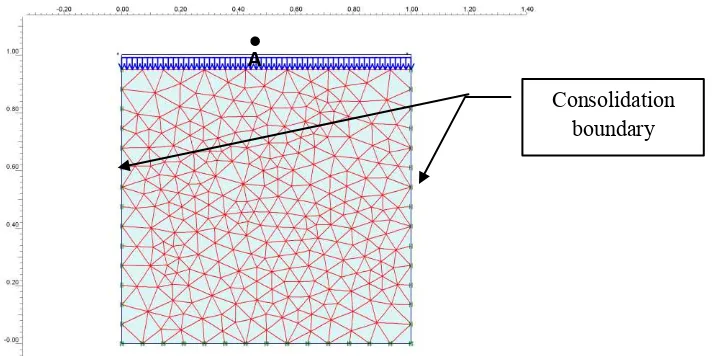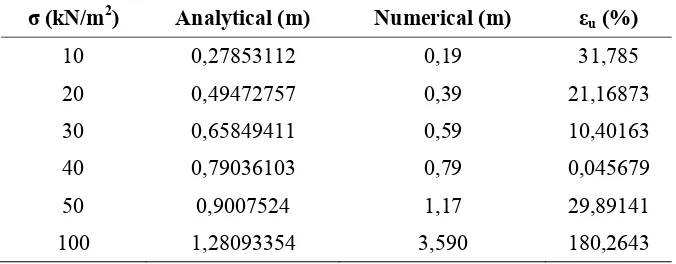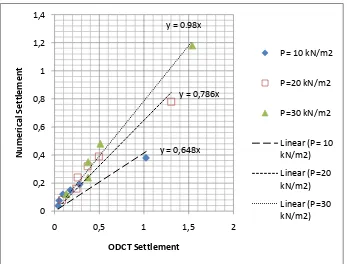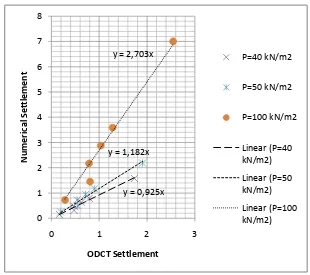@2012 Pusat Penelitian Geoteknologi 81 Lembaga Ilmu Pengetahuan Indonesia
COMPARISON OF OVERCONSOLIDATED CLAY
SETTLEMENTS CALCULATED BY ANALYTICAL 1D
TERZAGHI CONSOLIDATION AND BIOT NUMERICAL
ANALYSIS
Arifan Jaya Syahbana and Dwi Sarah
ABSTRACT Consolidation is a phenomenon where air and water in the soil skeleton (i.e clay soil) are forced out due to loading. This condition can occur when clay soil is subjected to loading resulted from pressure in laboratory test, land fill or embankment, building and other structures in the field. Many studies have examined the consolidation of soil through numerical methods and One Dimensional Consolidation Theory of Terzaghi but rarely find a comparison between them. This study aims to find comparison of settlement due to consolidation based on the two methods. A simple simulation using different thicknesses of soil and different loading condition was carried out on saturated and
homogenous overconsolidated soil. The
settlement calculations were performed by analytical Terzaghi method and numerical analysis. The results obtained for the varied thickness of the soil samples show varied value of relative error which indicates that thickness is one of the factors contributing to the discrepancy of settlement between the methods. Variation of loading condition in each sample showed that the calculation results of two methods would be the quite similar if the loading is in the range of 40-52 kN/m2. Greater loading out of that range would cause the results of analytical analysis to be less than the numerical analysis.
Keywords : consolidation, Terzaghi, Biot, Analytical, numerical
ABSTRAK Konsolidasi merupakan peristiwa
dimana udara dan air dipaksa untuk keluar dari struktur padat tanah. Hal ini dapat terjadi pada
saat tanah lunak (lempung) mengalami
pembebanan yang dapat berasal dari percobaan di laboratorium, penimbunan tanah, bangunan atau infrastruktur yang lain. Berbagai studi mengenai konsolidasi melalui metode numerik dan teori konsolidasi Terzaghi satu dimensi telah banyak dilakukan akan tetapi jarang sekali membahas hubungan perbandingan antara keduanya. Studi ini bertujuan untuk menentukan perbandingan penurunan menggunakan kedua metode tersebut. Metode yang digunakan
menggunakan simulasi sederhana dengan
melakukan perubahan pada ketebalan sampel tanah dan perubahan pembebanan. Tanah yang diuji dianggap sebagai tanah jenuh dan homogen. Penurunan dihitung berdasarkan metode Terzaghi dan numerik. Hasil yang diperoleh pada kondisi perubahan ketebalan contoh tanah menunjukkan nilai kesalahan relative yang bervariasi, hal ini menunjukkan bahwa ketebalan tanah merupakan salah satu factor yang berkontribusi terhadap perbedaan hasil perhitungan penurunan menggunakan kedua metode di atas. Perhitungan dengan kondisi perubahan beban menunjukkan hasil bahwa jika pembebanan berada direntang 40-52
kN/m2, maka hasil perhitungan penurunan tanah
akan relatif sama. Pembebanan yang lebih besar dari rentang tersebut menghasilkan penurunan hasil perhitungan analitik yang lebih kecil daripada hasil analisis numerik.
Kata kunci : Konsolidasi, Terzaghi, Biot,
Analitik, Numerik
INTRODUCTION
Consolidation is a phenomenon in which air and water in soil seleton, i.e. clay soil, are forced out when subjected to loading.
Naskah masuk : 7 Mei 2012 Naskah diterima : 7 November 2012 _______________________________
Arifan Jaya Syahbana
Pusat Penelitian Geoteknologi LIPI
Komplek LIPI, Jalan Sangkuriang, Bandung 40135 Email : [email protected]
Dwi Sarah
Pusat Penelitian Geoteknologi LIPI
82 The subjected loading may result from the
applied pressure during the laboratory test, landfill or embankment, building and other structures in the field. Consolidation of soil was first proposed by Karl von Terzaghi well known as the One Dimensional Consolidation Theory (ODCT) (Terzaghi, 1925). Because of its simple application, this method has been widely used in geotechnical engineering for consolidation calculation. As the development of consolidation theory, Biot derived a consolidation equation which considered the general interaction of soil skeleton and pore water capable of solving three-dimensional consolidation problem and further was used in dynamic analysis, it combines the seepage and deformation of the saturated soil, but it is difficult to get the analytical solution (Zhang et al., 1992).
As the advancement of the development of numerical analysis, many fields, including geotechnical area, started using numerical analysis to solve their problems. One of geotechnical numerical programs used is Plaxis (Brinkgreve, 2002a). Plaxis is a 2-D finite element code program which formerly had the objective to conduct uncomplicated analysis of finite element in the case of river embankments in Holland lowland. In subsequent years, Plaxis began to cover most area of geotechnical engineering (Brinkgreve, 2002a). In recent years, a substantial amount of research has been conducted on settlement using numerical analysis. For instance, Sari et al., (2008) reported on the consolidation behavior of multi-column supported road embankment using Plaxis, which concluded that Plaxis result is relevant to the settlement observed in the field where settlement in the center of embankment is bigger than in the toe of embankment. Chuan et al., (2010) performed One Dimensional Consolidation with non-Darcian flow using numerical analysis by finite difference which concludes the rate of consolidation based on non-Darcian flow is slower than that based on Darcy’s flow. Castro and Sagaseta (2011) carried out the numerical analysis to evaluate analytical solution in term of consolidation and deformation around stone columns. The computed values of the most important soil responses, such as the settlement reduction, the stress concentration factor and the dissipation of the excess pore pressure, agree well with an analytical solution that was recently
developed by the authors (Castro and Sagaseta, 2011) for degrees of consolidation higher than 40%. For analysis of consolidation by Biot theory using Plaxis, the validation manual reference (Plaxis, 1998) stated its capability of consolidation analysis; however the exact discrepancy of consolidation settlement results between numerical analysis using Plaxis and analytical Terzaghi method is still not clear. This paper aims to establish comparison of settlement calculation by Terzaghi (analytical) and Plaxis (numerical Biot calculation).
A simple simulation using different thicknesses of soil and different loading condition was carried out on saturated and homogenous overconsolidated soil. The settlement calculations were performed by analytical Terzaghi method and numerical analysis. Overconsolidated soil properties are taken from a site in Semarang city (Sarah et al., 2011). Poisson ratio is also modified in respect to Terzaghi one dimensional consolidation assumption that displacement in lateral direction is not allowed.
THEORY OF CONSOLIDATION
Calculation of consolidation settlement can be made by analytical calculation based on one dimensional consolidation theory of Terzaghi and Biot theory using Plaxis numerical package. Brief explanations of both methods are explained preceded by the illustration of consolidation process.
Illustration of Consolidation Process
83 piston (dissipation process). Due to this
condition, pore water pressure decrease from ua to u0 again, until the end of consolidation (steady state condition). The process from Figure 1.b until Figure 1.c is known as the consolidation phenomenon.
One Dimensional Consolidation Theory of Terzaghi
One Dimensional Consolidation Theory of Terzaghi (ODCT) assumes that strain and water flow in soil skeleton are only in vertical direction. Besides that, there are several other assumptions: (1) soil is homogenous, (2) soil in saturated condition, (3) solid and water particle are not easy to be compressed, (4) air obeys Boyle’s law, (5) Darcy’s Law is applied along hydraulic gradient, (6) permeability coefficient and volumetric coefficient are constant during consolidation process, (7) the effects of temperature change, air dissolved in water, air diffusion, and generation and diffusion of vapor are disregarded (Qin et al., 2008). In order to calculate the settlement, thickness (H), coefficient of compression (Cc) and coefficient of recompression (Cr) are needed. Mathematical equation of settlement can be seen in Equation 1.
'
Biot Theory of Consolidation
Plaxis software package utilizes Biot theory to calculate consolidation. Biot theory is the development of Terzaghi principle where in Biot theory consolidation problem may be extended to three dimensional (Biot,1956). Plaxis is able to calculate variables such as settlement and pore water pressure dependent with time and nodal coordinate in simulated model. Equation used in this simulation is as the following.
n
Figure 1. Simple experiment of consolidation Steady state (b) Loading (c) Water drain (d) Top view of cylinder piston (adapted from Hardiyatmo, 2007)
84 Kis the stiffness matrix, Lis the coupling
matrix,
d
f
nis the incremental load vector,d
v
isthe incremental displacement at nodal and n
p
d
isthe incremental pore pressure (Brinkgreve, 2002b).
METHODOLOGY
Numerical modeling using Plaxis package and analytical ODCT calculation were carried out in this study. The soil model and properties used are explained in section 3.1.
Soil Model and geotechnical properties
The soil model used in this study is rectangular with dimension of width (w) = 1 m and varied height (H), i.e. 1 m, 2 m, 3 m, 4 m, 5 m and 10 m. This variety is used to understand how much the influence of soil thickness in respect to settlement relative error between analytical and numerical analysis. Figure 1 illustrates the model used. The rectangular model is used to simulate the process of consolidation in subsurface. Application of load is solely from vertical direction. Horizontal strain is restricted in all area of model and the flow of pore water is only in vertical direction. Soil model is homogenous overconsolidated clay and ground water table is set at soil surface, thus soil is in fully saturated condition.
For Plaxis consolidation modeling, the boundary condition is as illustrated in Figure 2. Consolidation boundary was made in left and right side only due to similarity with Terzaghi method used in analytical analysis. Load applied in this simulation is 10 kN/m2. Plane strain with 15 nodes triangle was used in this study. Settlement is calculated at the surface (point A). Chosen material properties for soil is Mohr-Coulomb, meshing was made by fine global coarseness.
Geotechnical Properties
Soil sample utilized in the modeling is an overconsolidated soil excavated from the depth of 20-45 cm from the surface of Semarang City (Sarah et al., 2011). The resume of geotechnical properties is presented in Table 1.
Constraint
H
w
Figure 1. Model used in this study
Consolidation boundary
A
85 Figure 3. Consolidation Curve (relationship between void ratio and effective pressure)
0 0,2 0,4 0,6 0,8 1 1,2 1,4 1,6
0,01 0,10 1,00 10,00
V
oi
d
r
a
ti
o
Pc' (kg/cm2)
Table 1. Geotechnical Properties of Soil Model
SG w
(%)
γ
(kN/m3)
γsat (kN/m3)
E
(kN/m2) ν k (m/s)
2.752 54.04 16.16 16.68 250 0.00 2.24x10-7
Table 2. Parameter of soil for Terzaghi analysis
Cc Cr e0 p0’ (kN/m
2
) pc’ (kN/m2)
0.82 0.17 1.62 -depend on
86 For ODCT calculation, the properties are
mentioned in Table 2. Value of elasticity modulus was taken from the range of prediction value of soft-very soft clay by Bowles (1997). Lateral strain in all area of model is not permitted hence the value of Poisson ratio is set to zero. Effective overburden pressure is obtained by multiplying the soil density by half the depth, thus by varying the depths shall result in different values.
Laboratory test result of consolidation can be seen in Figure 3. Figure 3 explains that when the effective pressure applied bigger than 18 kN/m2 (preconsolidation pressure), settlement will increase significantly because the gradient of Cc is usually always bigger than Cr.
Two scenarios of simulation are considered, the first is alternating the soil thickness with constant loading of 10 kPa and the second one is by varying loading condition with constant soil thickness.
RESULTS AND DISCUSSION
Results of Settlement Calculation
Based on above data, the settlement can be calculated by Terzaghi method as the following. For thickness 1 m,
.62 0.039
6.68 x 0.5
6.68) x 0.5 (10 l og 1 1
1 0.17 Sc
= 0.039 m
Table 3. Settlement by analytical and numerical analysis for variation of soil thickness (applied load 10 kN/m2)
H (m) Analytical (m) Numerical (m) εu (%)
1 0,03902274 0,038 2,620894
2 0,05157353 0,075 45,42343
3 0,09289225 0,12 29,18193
4 0,17531832 0,15 14,44134
5 0,27853112 0,19 31,785
10 1,02205172 0,38 62,81989
Table 4. Settlement by analytical and numerical analysis for variation of loading condition
σ (kN/m2) Analytical (m) Numerical (m) εu (%)
10 0,27853112 0,19 31,785
20 0,49472757 0,39 21,16873
30 0,65849411 0,59 10,40163
40 0,79036103 0,79 0,045679
50 0,9007524 1,17 29,89141
87 Following previous manner both in analytical and
numerical analyses, the results of settlement calculation for varying thickness of soil and constant loading condition and its relative error can be seen in Table 3. Relative error between two methods above is calculated as in equation 3 (Wang et al., 2007).
ε
u calculatedanalyticanalytic
Figure 4. Relationship between loading and relative error in varied thickness.
88 analytic is settlement value based on Terzaghi
calculation.
The relative errors presented in Table 3 show a wide range of values. This condition indicates that the thickness is one of the factors contributing to the discrepancy between analytical and numerical settlement calculation for this loading condition.
To further observe relationship between the numerical analysis and analytical calculation, the applied load are also varied to 10, 20, 30, 40, 50, and 100 kN/m2 with constant thickness of clay soil of 5 m and the result is shown in Table 4.
To understand more about the relative errors through loading variation and varied thickness, the graphical results are presented in Figure 4 here the settlement from various thickness and loading is presented.
The graph indicates that for the applied load range of 10-40 kPa the relative error tends to decrease with load. While for the applied load of 50 and 100 kPa, the graph shows increment of relative error.
Moreover, numerical analysis shows the tendency that if the loading applied on soil is larger than 40-52 kN/m2, then the calculation result is larger than analytical method. Vice versa, if applied loading is less than 40-52 kN/m2, then the calculation result is less than ODCT method.
Relationship between the two methods in each loading and thickness conditions is summarized as shown in Figure 5.
Figure 5 shows that the higher loading condition the settlement resulted from numerical analysis would be higher compared to the analytical
Figure 6. Relationship of settlements calculated using numerical analysis by Biot theory and analytical analysis by Terzaghi one dimensional consolidation theory for 10-30 kPa loading condition
y = 0.98x
y = 0,648x y = 0,786x
0 0,2 0,4 0,6 0,8 1 1,2 1,4
0 0,5 1 1,5 2
Nu
m
e
ri
ca
l S
e
tt
le
m
e
n
t
ODCT Settlement
P= 10 kN/m2
P=20 kN/m2
P=30 kN/m2
Linear (P= 10 kN/m2)
Linear (P=20 kN/m2)
89 Figure 7. Relationship of settlements calculated using numerical analysis
by Biot theory and analytical analysis by Terzaghi one dimensional consolidation theory for 40-100 kPa loading condition range of 40-52 kN/m2 the settlement results using both methods seem to be almost similar with settlement value is less 0.4 m. Settlements results by analytical ODCT show higher results afterwards.
Based on the above data, correlations between numerical analysis and ODCT are presented in Figure 6 and 7. The bold line indicates that both analyses will result the same settlements if specified loading range is applied, i.e. between 40-52 kPa. When different loading range is used the correlation between settlement calculation based on numerical analysis and analytical ODCT can be looked up in Figure 6 and 7.
Figure 6 and 7 indicate that when the pressure applied is below 40 kN/m2 the resulted settlement from numerical analysis will be smaller than that from ODCT analysis. On the other hand, when the applied pressure is more than 40 kN/m2 the settlement resulted from numerical analysis will be higher than ODCT analysis.
DISCUSSION
Simple simulation to compare the analytical one dimensional consolidation theory of Terzaghi and numerical analysis by Biot theory using Plaxis
package had been carried out to an
90 the numerical analysis by Biot theory using
Plaxis package considers consolidation as two dimensional (x,y) problem, therefore as loading condition in thicker model increases, so is the value of the horizontal effective stress. As the result, the total strain and displacement are larger than that resulted from analytical method of Terzaghi consolidation where the strain in horizontal direction is neglected (only vertical strain allowed).
During low loading condition, the different thickness of soil does not give significant influence to the relative error between the two methods. The reason of this phenomenon is in a thin model where, the horizontal effective stress is relatively small, so the vertical effective stress component is more dominant to influence the total settlement. Therefore, in this case, the Plaxis analysis and analytical one dimensional consolidation of Terzaghi would have similar results.
CONCLUSION
Comparison between the analytical one
dimensional consolidation of Terzaghi and Biot consolidation theory by numerical analysis through Plaxis package had been carried out. The simulation results by varying the soil thickness with the same loading condition had shown a good relationship between both analyses with a fairly low relative errorr. When alteration of loading was conducted, relative errors of the two methods seem to have the same tendency. In the range of 40-52 kN/m2 loading, the two methods have similar results of settlement calculation. When the applied loading is higher than that range, numerical analysis has higher result than the analytical OCDT method. Alternatively if applied loading is less than that range, the analytical method has higher settlement result. This condition is attributable due to the alteration of horizontal effective stress during consolidation process. Further field validation of this simulation is required to verify the simulation results.
REFERENCES
Biot, M.A., 1956, General Solutions of the Equations of Elasticity and Consolidation for a Porous Material, Journal of Applied Mechanics, New York 78, 91-96.
Bowles, J.E, 1997. Foundation Analysis And Design 5th edition, The McGraw-Hill Companies, Inc, Singapore, 125 pp.
Brinkgreve,RBJ, 2002a. Plaxis V.8 General Information, A.A Balkema Publisher, Netherland.
Brinkgreve,RBJ, 2002b. Plaxis V.8 Scientific
Manual, A.A Balkema Publisher,
Netherland.
Castro, J., Sagaseta, C., 2011. Consolidation and
deformation around stone columns:
Numerical evaluation of analytical solutions, Computers and Geotechnics 38 354–362.
Chuan, X.L., Kang, H.X., Kun, W., 2010. Analysis of 1D consolidation with non-Darcian flow described by exponent and threshold gradient, Journal of Zhejiang University-SCIENCE A (Applied Physics & Engineering). Plaxis BV, Delft, Netherlands.
Sarah, D., Murdohardono, D., Soebowo, E., Lubis, R.F., Mulyono, A., 2011. Amblesan Tanah di Pulau Jawa: Kasus dan Konsep Penghitungan Amblesan tanah di Kota Semarang, Condensed Abstract Pemaparan Hasil Penelitian Puslit Geoteknologi LIPI 2011, Bandung, Indonesia
Sari, W. A., Jun, J.Z. , Bao, G.C., 2008. Finite Element Modeling Of The Consolidation Behavior Of Multi-Column Supported
Road Embankment, Computers and
Geotechnics 36, 676–685.
Terzaghi, K.. 1925. Erdbaumechanik auf bodenphysikalischer Grundlage, Deuticke, Wien.
Qin, A.F., Chen, G.J.,Tan, Y.W., Sun, D.A.,
2008. Analytical solution to
91 Wang, W.D., Wang, J.G., Wang, Z.L, Nogami,
T, 2007. An unequal-order radial
interpolation meshless method for Biot’s consolidation theory, Computers and Geotechnics 34, 61–70.






